Video Slideshow
On OAT's Ancient Kingdoms: Thailand, Laos, Cambodia, Vietnam , we were immersed in the vibrant cultures that have emerged in the wakes of lost empires. Traveling the Indochina peninsula through Thailand, Laos, Cambodia, and Vietnam, we connected with locals who shared their homes, markets, and schools with us. We slipped into daily life for A Day in the Life of a Laotian village, where we met young schoolchildren and Hmong villagers. We experienced the quiet tranquility of the early morning alms-giving ceremony with local monks.
Bangkok

Bangkok is the capital of Thailand and a regional force in finance and business. It is an international hub for transport and health care, and has emerged as a center for the arts, fashion, and entertainment. The city is known for its street life and cultural landmarks, as well as its red-light districts.
Bangkok traces its roots to a small trading post during the Ayutthaya Kingdom in the 15th century, which eventually grew and became the site of two capital cities: Thonburi in 1768 and Rattanakosin in 1782. Bangkok was at the heart of the modernization of Siam, later renamed Thailand, during the late-19th century, as the country faced pressures from the West.
We took a boat cruise on the Chao Phraya River and connecting Bangkok Noi Canal which contained a lock so we waited for the water level to change. The boat captain gets only $2/trip! Lots of temples along the canal. The boat dropped us off at Ruen Khun Yaai ("Grandmother's House") where we had a food demonstration. Jason did the main cooking. Had three dishes (red curry, a loofa dish, chicken and mushrooms).
Ayutthaya (about 50 miles north of Bangkok). Town of about 6,000 people. It is the Ancient Kingdom of Siam and a UNESCO site. This UNESCO World Heritage Site was home to 33 kings from many different dynasties. The capital of Siam from 1353 to 1767, the city was once a place of such fabulous wealth that early travelers described its "2,000 spires clad in gold."
Brick ruins. Had many, many Buddha and all except a few large statues had their heads removed. It's a very peaceful site. There were two main areas: the temple ruins were for the people (Wat Mahathat) and the royal temple used for religious ceremonies for King and royals (Wat Phra Sri San Phet) was within the Palace Walls.
We took a short walk to local shop where they make roti sai mai (Thai cotton candy). We entered the shop and went to the basement where various individuals had their own businesses that did different parts of the process.
Luang Prabang

Luang Prabang, Laos, was listed by UNESCO in 1995 for unique and "remarkably" well preserved architectural, religious and cultural heritage, a blend of the rural and urban developments over several centuries, including the French colonial influences during the 19th and 20th centuries.
Our group took Jumbos to main area of town where the large outdoor street market is held. In the middle of the street, we climbed 328 steep uneven steps to Phusi Hill to see the view. At the top is a small temple with a Buddha; the entire area at top is very crowded (mostly Chinese tourists) as people sit up there and wait for the sun to set.
We cruised on our own open-air long/low boat along the Mekong River "other of all rivers" which supports some 90 million people who produce 54,000 square miles of rice every year. Also home to more species of giant fish than any other river, this majestic waterway is said to produce balls of light along its surface, which the locals attribute to the Phaya Naga, or Mekong Dragons. Stopped at a village where they make river weed chips. Sylvia helped the old lady prepare the weed by pounding, adding tomatoes, garlic and then they dry the weed for at least a month. After it is dried, it is rolled up and eventually sold as a delicacy (had some later and it was delicious).
We continued on the river to Pak Ou Cave and walked up numerous steps to see a cave with with thousands of Buddha statues. Upon entering the cave, each of us got a marigold wrapped in a leaf with a candle. The candle was lit and you said a prayer in the front of the main Buddha.
Back in town we met to go see the oldest temple in this region. It contained a series of temples in a large complex. Spent about one hour walking around before sunset. Most of the temples here had mosaics of glass in their outside walls.
Perhaps the most spiritual activity we experienced was alms-giving to local monks in the early morning hours. We were given a bowl each of sticky rice to be doled out to the orange clad Lao robed monks as they walked by. Problem was that the sticky rice gets stuck and it's hard to grab a golf ball size amount to put in the monk's container before the next monk is there for his allotment. We ran out of rice before we ran out of monks; hundreds of monks do this every morning all over town! We then walked a few yards to the temple and gave two young monks fruit in return for a blessing.
Vientiane
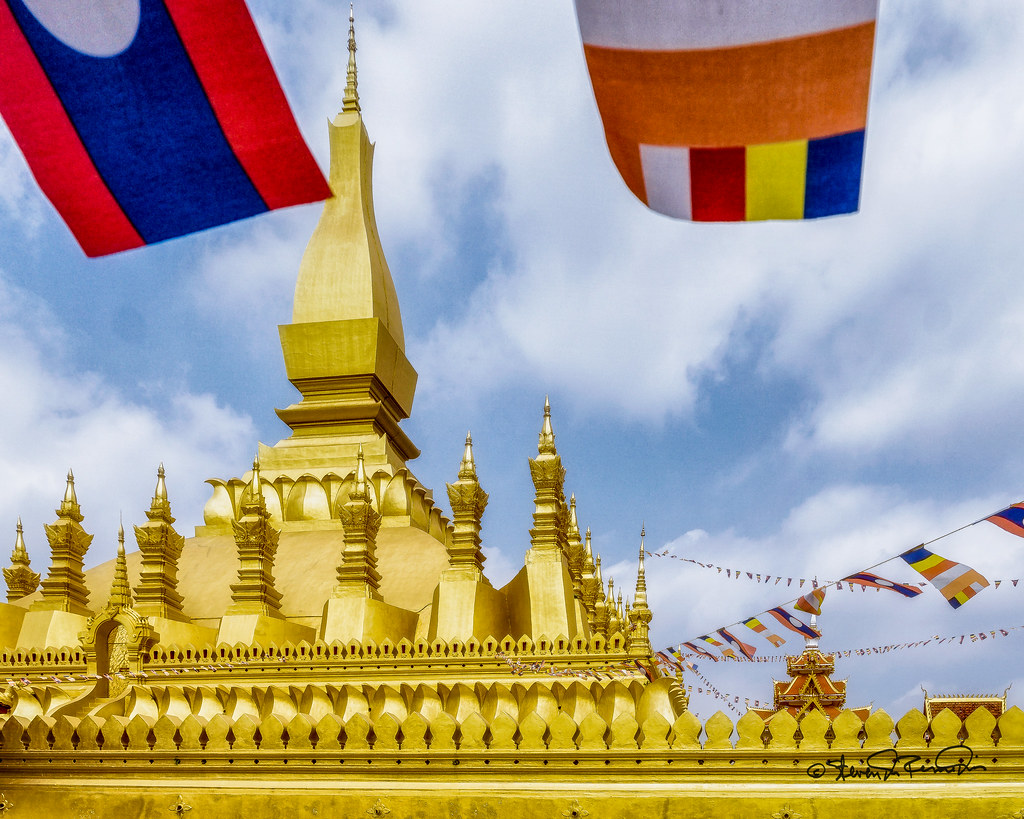
Vientiane became the capital in 1563 due to fears of a Burmese invasion but was later looted then razed to the ground in 1827 by the Siamese (Thai). It's famous as the home of the most significant national monument in Laos: That Luang, which is a symbol of Laos and an icon of Buddhism in Laos.
Our first activities were an orientation walk followed by our home-hosted dinner. Our dinner host's sister (Sun) picked us up in a nice new large SUV. She lives with her sister Nom (Nom is the real host) and son (Fon) above an auto shop that her sister owns and is about 15 min away from the hotel. We helped to make a few dishes and served in a nice dining room. After dinner, we went into another room and received blessings and exchanged string bracelets in a Baci ceremony.
The follwing day we went inside the Wat Sisaket Museum (oldest Buddhist monastery in Laos) to talk to two monks (a novice who was 20 yr old and an ordained monk about 23 yr old) about daily life of a monk. Both are soft spoken. We asked questions for about 45 minutes and saw how they wrap their robes. Then we went to visit the golden-domed Prathat Luang (Great Sacred Stupa) (a national symbol of Laos built in the 16th century) and on to Patuxai (Victory Gate Monument) that looks like the Arc de Triumph. That evening our guide arranged for a dinner show of traditional Lao dance.
Phnom Penh

Phnom Penh. the capital of Cambodia, once known as the "Pearl of Asia," was considered one of the loveliest French-built cities in Indochina in the 1920s. Founded in 1434, the city is noted for its historical architecture and attractions. The main tourist attractions are the Royal Palace with the Silver Pagoda and Wat Pho with an enormous reclining Buddha.
We visited Choeung Ek Genocide Center, the largest killing field of the 388 killing sites (called re-education centers) in Cambodia (located 11 miles south of Phnom Penh) where thousands were tortured and killed. This was previously a Chinese cemetery and in 1980, mass graves of 8,895 were discovered. Of the 129 mass graves discovered at this site, only 86 were excavated. Today, Choeung Ek is a memorial, marked by a Buddhist stupa. The stupa has acrylic glass sides and is filled with more than 5,000 human skulls. Some of the lower levels are opened during the day so that the skulls can be seen directly. Many have been shattered or smashed in.
Later, we visited S21 (Tuol Sleng Prison), a prior high school converted into a notorious detention center, where only seven of the roughly 20,000 people imprisoned there are known to have survived. We spent time talking the one of the two living prisoners of the seven who survived. In this prison, people were tortured, interrogated and then killed. Mr. Chum Mey, 88 years old, talked about his life at the camp (1978) and how he was able to survive (he could repair the typewriter that the administrators needed for communications.)
Later we drove past the Royal Palace, the Silver Pagoda (Wat Preah Keo Morokat), which draws its name from the more than 5,000 silver tiles that cover its floor.), had drinks at Raffles Hotel Le Royal (happy hour at their famous "Elephant Bar"; fabulous G&Ts) built in 1929 and where Charlie Chaplin and Jackie Kennedy stayed. Afterward we went dinner on our own at FCC (the former Foreign Correspondence Club).
Rural Cambodia
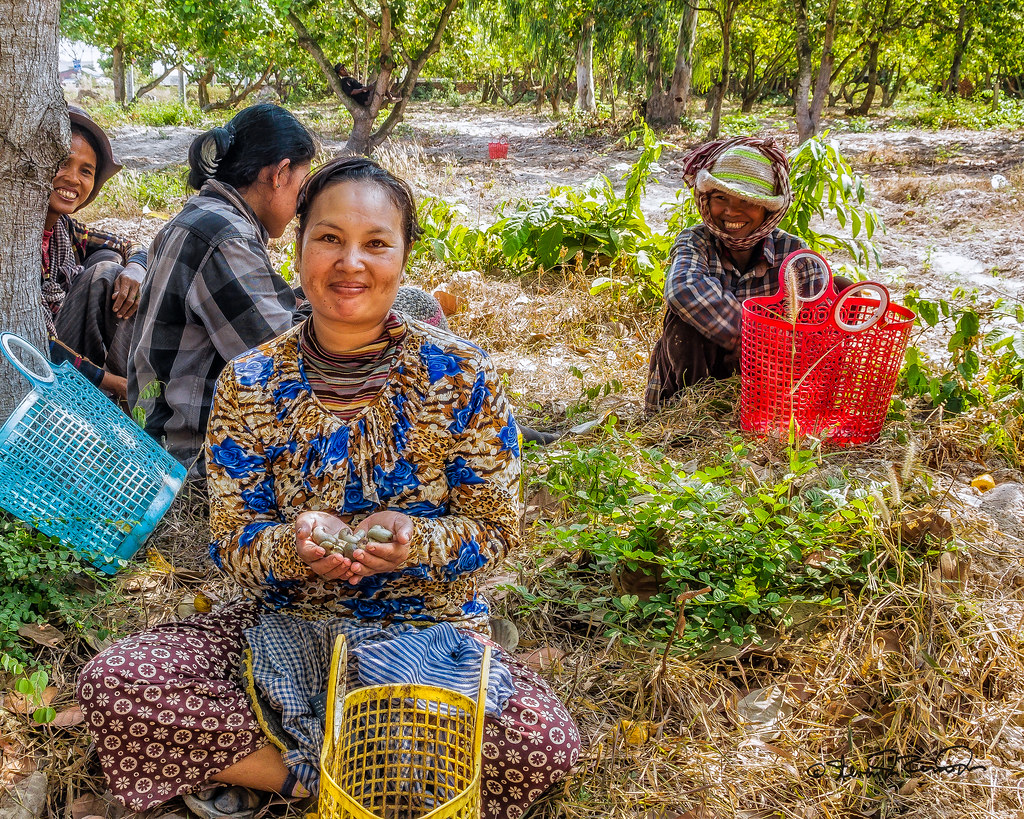
We drove by bus from Phnom Penh to Siem Reap through Cambodian countryside. There were several interesting stops along the way.
We stopped along way to walk to a lotus flower pond. There were flowers in all stages from buds, blossoms to seeds. When the flowers die, the seed pod turns green and has tasty seed treats.
Another stop took us to a woman's home where she told us about her tarantula business. She showed us how to hunt for tarantulas on her farm (getting about 20 - 30 per day from the fields). After she defangs them she sells them either live or fried! She fried a bowl of tarantulas, scorpions and crickets for us to eat.
As we continued our drive we noticed people working in a grove of cashew trees, so we stopped to visit with them for a few minutes. The fruit looks like a yellow pear/apple with one very large nut at the bottom of the fruit. The outer shell is poisonous!
Our guide took us to see a 1000 year old bridge called Kampong Kdei. It is said to be the world€™s longest corbelled arch bridge and was built wide enough to accommodate the elephants used at that time.
Siem Reap
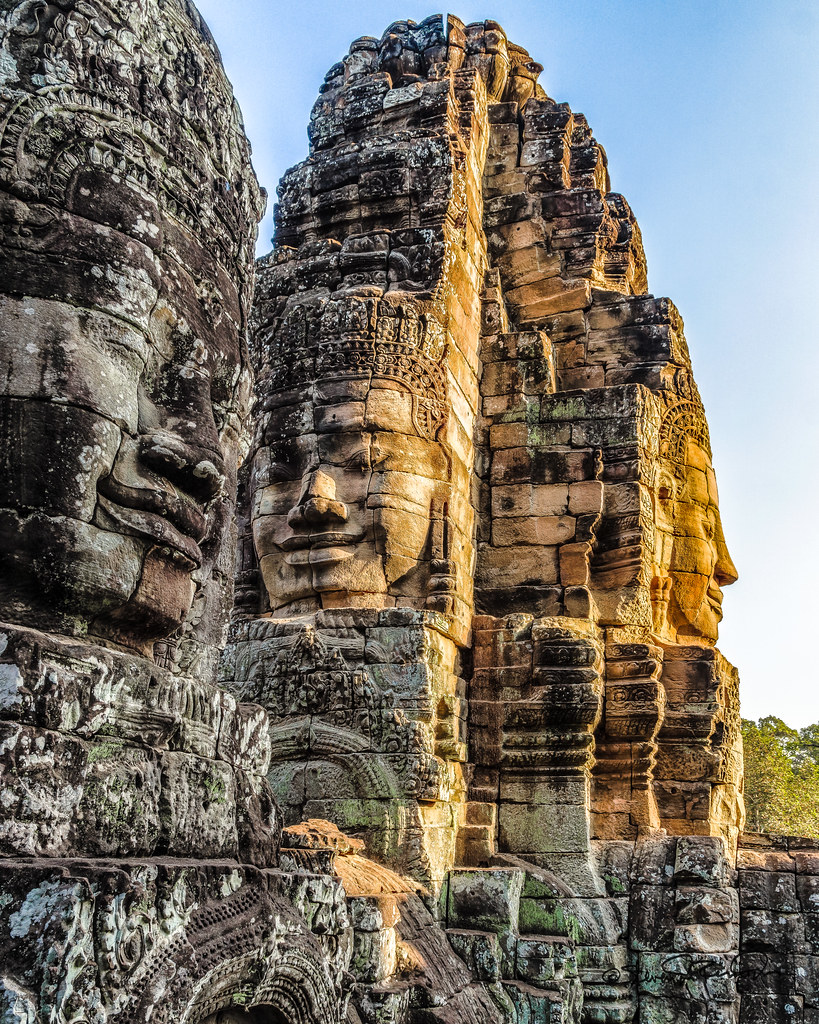
Siem Reap, Cambodia, has colonial and Chinese-style architecture in the Old French Quarter and around the Old Market. Today it has a large number of hotels, resorts, restaurants and businesses because of its proximity to the Angkor City temples, the most popular tourist attraction in Cambodia.
We set off to the floating village on the Tonle Sap Lake, the largest freshwater lake in Southeast Asia. On the way we took a 20 minute ride on a water buffalo-drawn cart through the village of Tajet with 800 people. The floating village of Mechrey has about 1,200 residents who change location depending on the lake level which varies with the seasons. The village supports all aspects of daily life afloat - stores, schools, gas stations, etc.
We stopped to visit the village midwife and her fisherman husband. She has aided in 10 of her grandchildren's births and over 300 others because there is no hospital in the area or medical care. She is quite the matriarch of the family and a major medical support for the community.
Later we headed out to Angkor Thom, a late 12th century city containing the 12th-century Bayon where there are over 200 smiling faces. This temple structure's 54 stone towers are embellished with massive grinning heads that symbolize the spirit of one of Cambodia's most beloved kings, Jayavarman VII. There are five gates to enter Angkor Thom built by J-VII. Before one gate, there is a long bridge with statues of heads (depicting demons and gods) lining both sides of the bridge.
Early next morning we visited Angkor Wat, a masterpiece of Khmer architecture. It's a large pyramid temple, built between 1113 and 1150, surrounded by a great moat 570 feet wide. Built in 1113-1150, we set off for the west gate. We went to level one and two but by 10:30, the line for level three was over 45 min long so we chose not to spend time in a line with the hot sun overhead. Relief stories filled the long hallways. There are numerous temples at AW, including pools, large roots of trees growing around stones.
We took an optional tour to Banteay Srei temples, also known as "the Women's Temple". The pink stone temple is one hour's drive (20 miles) from Siem Reap. The drive there through the rural countryside was very interesting in that you saw everyday activity near the homes along the road. Once at the temple, it got crowded quickly (of course, Chinese tourists who love to each get their picture taken in every arch way and block the path for others). This temple was built by Raja Kuru in 967AD who was a teacher and top advisor to the King and therefore smaller than most. But it had the most intricate carvings and is one of the most beautiful and well preserved temples in Cambodia. It is dedicated to Shiva in 967AD and is still in great condition (200 years older than Angkor Wat) due to the pink soapstone which is considered the best quality. Nothing here has been recarved and it has retained the original carvings. Quite astonishing and one of our favorite temples.
Ho Chi Minh City
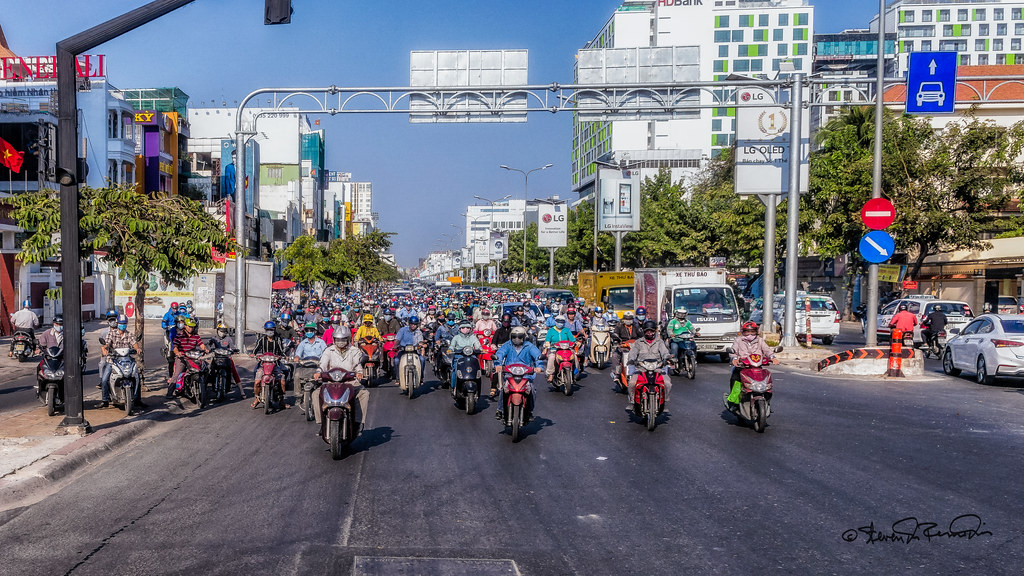
Ho Chi Minh City, Vietnam, holds a vivid image in our memory. Under the name Saigon, it was the capital of French Indochina from 1887 to 1902 and again from 1945 to 1954. Saigon would later become the capital of South Vietnam from 1955 until its fall in 1975.
We departed for the Mekong Delta area 50 miles southwest of Saigon on the upper Mekong River. We stopped for coffee and tea at an outdoor cafe beside the road and checked out the numerous hammocks available to us. Took a Vietnamese wood boat ride to village of Ben Tre across the Mekong river. Walked along a canal to the rowing dock for a sampan boat and then took a leisurely short ride along the canal to visit to a local place where coconut candy (sweet keo dua) is made.
Weather was perfect for our XO Food Tour and we left hotel during rush hour to merge into the chaotic traffic of Saigon on the back of motorbikes. What fun. We had a ride to the first of three food stops (14 dishes total including Pho [fuh!]; BBQ of goat, meat, chicken; Seafood dishes (scallops, clams, and shrimp), a 20 minute ride to walk through the 24 hour Chinese market, a stop at the new (and rich) area of the city. The four of us felt that this night was definitely a highlight and one of the most exciting tours to take. Afterwards, we all went to the hotel's outdoor terrace for drinks.
We took a tour of Independence Palace and grounds (complete with replicas of the tanks that were on the grounds that fateful day), we went to a nearby neighborhood to see a Hidden Bunker armory that the Viet Cong had in the middle of the city!
We traveled about 2 hours northwest of the city to see the Cu Chi Tunnels in a less crowded area. The tunnels, a 125-mile-long underground maze where thousands of fighters and villagers hid and fought during the Vietnam War, referred to by locals as the "American War." The South Vietnamese Communists, or Viet Cong, built this vast network of tunnels in and around the district of Cu Chi and worked continually over 25 years to expand the multi-level network.
Red Dragon Junk
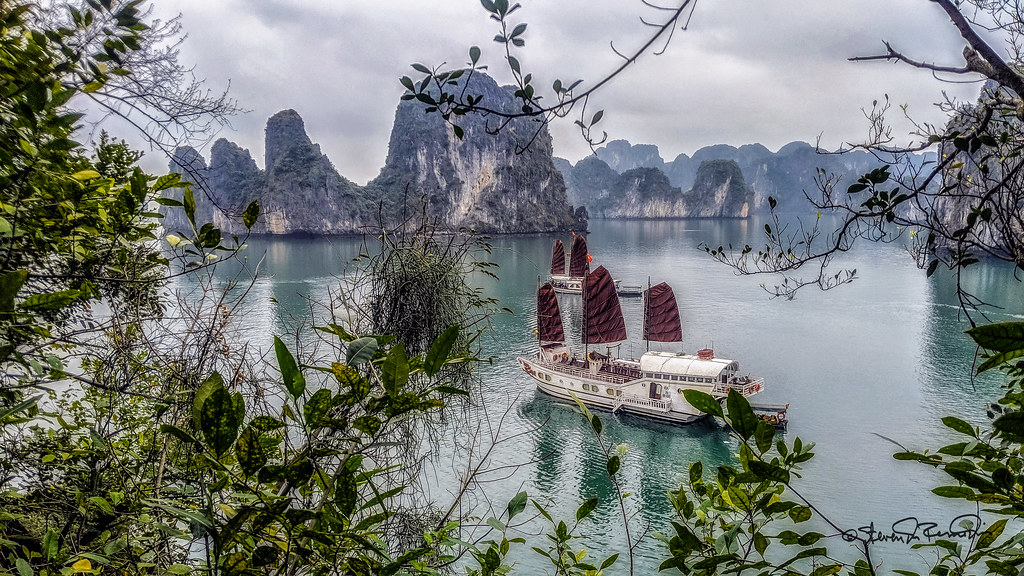
Ha Long Bay and Bai Tu Long Bay are famous attractions in north Vietnam. These waters contain hundreds of small limestone islands that create a beautiful setting for cruises.
Our cabin was in the bow of the boat and quite spacious as it had a double bed and a twin bed. Day was overcast and we had a slow ride through Ha Long Bay further out to Bai Tu Long Bay. Relatively good meals. Our guide was Mr. T who ended his sentences typically with a laugh reminiscent of Peter Lorrie!
We boated to an island and walked up steps and into the limestone cave featuring stalagmites and stalactites. Many of us went kayaking around one of the rock islands. After having our BBQ on the beach, the sun finally was starting to show and the beach started to get hot.
On our return trip we stopped in a protected lagoon and transferred to a small row boat rowed by an islander (this is how they make most of their money) which went through a floating village with its numerous dogs, through a rock arch and back to the lagoon. Then we went to a pearl farm to see how they seeded and harvested pearls.
Hanoi

Hanoi, the capital of Vietnam, was an American mystery during the twentieth century. Now it welcomes all visitors to see what has been accomplished under their flavor of communism.
Our first tour was two hours out of the city and our guide was Sin (Shing). We went to the largest pagoda in Vietnam called Bai Dinh which had 3000 steps and 500 Buddhas lining the long open aired hallways leading up through the three buildings built on different levels. Had to take a small tram for a long drive from the parking lot to the entrance of the pagoda complex. Lots of visitors but mostly locals and Chinese (of course!).
After lunch we drove to the Tam Coc River where we split into two boats each rowed by rowers using their feet. We went through three caves and saw goats, egrets, stork, pigs. Lots of people on the river with each rower using their feet! Started to drizzle on way back but the rowers had their hands free to use an umbrella.
Our second tour was a city tour that included Hanoi Hilton, Ho Chi Minh Mausoleum, the Old Quarter, Temple of Literature, Ethnic Museum, Train-track shops and a Cyclo tour of Old Hanoi.

